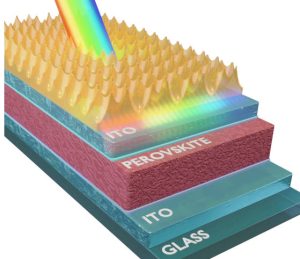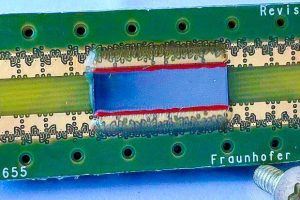
Planar magnesium fluoride anti-reflection coatings work on perovskite cells, but could the nano-scale surface texturing used on some silicon cells be applied to pervoskite cells?
This was the question asked at the University of Warsaw, which worked with the Fraunhofer Institute for Solar Energy (Fraunhofer ISE) to find an answer.
“To minimise losses, silicon cells are typically etched with corrosive chemical agents, a process that creates microscopic pyramid pattern on the surface, effectively reducing reflection,” according to the university. “Unfortunately, perovskites are sensitive to many chemical substances, which is why less effective planar anti-reflective coatings [planar MgF2] applied through less-invasive sputtering have been employed so far.”
Instead, the team tried ‘thermally assisted UV roller nano-imprint lithography’, adding a thin coating of the epoxy etch-resist SU-8 2002 to the top of the perovsite cell layers, then using a roller with defined surface structures to press a suitable pattern into it.
“The SU-8 resist serves as a medium that is moulded into the desired texture,” researcher Maciej Krajewski told Electronics Weekly. “The SU-8 also modifies the optical properties of the whole stack to create more advantageous conditions for light to coupled-in.”
This particular from of nano-imprint lithography “meets the criteria of reliable repeatability of high aspect ratio structures with high throughput and long stamp lifetimes”, according to Warsaw. “We showed that this process chain was harmless enough to not deteriorate the performance. To the best of our knowledge such or a similar structure has never been directly applied to a perovskite solar cell.”
It is also applicable to macro-scale surfaces – up to 100cm2.
“Until now, scientists applied similar anti-reflective structures as separately prepared layers, which were transferred in another process that was inevitably small-scale and susceptible to damaging the active layer,” said the researchers.
Un-coated. the solar-weighted reflectance of the cell was 13.6%, reducing to 2.7% with the nano-imprinted honeycombe, increasing output by 2.1mA/cm2, which is 0.5mA/cm2 better than the sputtered planar MgF2 coating, according to the paper ‘Nanoimprinted honeycomb texture as an efficient antireflective coating for perovskite solar cells’, published in Advanced Materials and Interfaces, which can be read in full without payment.
A mathematical model for the system has been developed, through which the imprintable medium and the anti-reflection pattern (a hexagonal ‘egg box’ honeycomb was used in the demonstration) can be optimised for particular situations – the particular perovskite solar cell created for this proof-of-concept is designed to be partnered with a silicon solar cell as part of a stacked hybrid tandem cell.
Image: Maciej Krajewski, faculty of physics, University of Warsaw
 Electronics Weekly
Electronics Weekly



